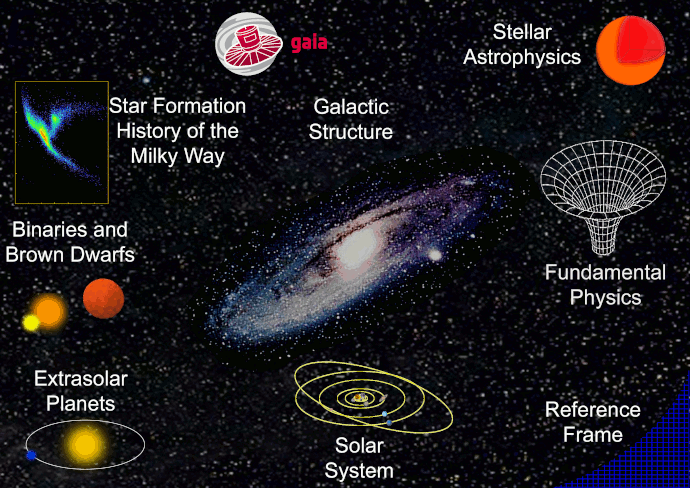
Areas of science touched on by Gaia. Download the large version of the image (1.21 MB). (Image courtesy of ESA.)
A successful Gaia mission will fundamentally change astronomy, by replacing with direct measurement what could till now at best be estimated based on a string of, often simplifying, assumptions.
The results of Gaia mission will enable us to make giant leaps in our understanding of a wide range of science topics, including:
- solar system studies through the detection of members of groups of asteroids that are difficult to observe from Earth, systematic detection of extra-solar planets;
- stellar structure and evolution through the much improved surveys of stellar clusters;
- galactic dynamics through the combined information on distances, space velocities and stellar spectral types;
- cosmology through the detection of large numbers of Quasi-Stellar Objects (QSOs) and a few thousand supernovae (see Guest Stars with Gaia: Mapping the Transient Sky and Supernovae: tools for Cosmology with Gaia);
- and fundamental physics through testing aspects of general relativity to an unprecedented accuracy.
Watch Science@ESA vodcast "Episode 6: Charting the Galaxy - from Hipparcos to Gaia" (courtesy of ESA) to learn more about the Gaia mission and its science. (Skip video.)
Download the script of the vodcast. "Episode 6: Charting the Galaxy - from Hipparcos to Gaia" is also available for download from ESA's website.
Gaia Data Release 2
The Gaia Data Release 2 (Gaia DR2) was published on 25 April 2018. For more information about DR2 and description of DR2 contents see Gaia Data Release 2 page.
Gaia Data Release 2 Science Workshops
The UK Gaia project (https://www.gaia.ac.uk) organised a series of one day Gaia DR2 workshops open to interested astronomers in the UK. These provided a basic introduction to the Gaia mission, an overview of the catalogue contents including scientific quality and practical information on how to handle and access them from the Gaia archive for science research.
Gaia Data Release 1
Gaia’s first data release was published on 14 September 2016. More information about Gaia Data Release 1 can be found on Gaia Data Release 1 page.
Contents:
- Positions and Gaia 'G' magnitudes for 1.1 billion stars using only Gaia data;
- Positions, parallaxes (distances) and proper motions for more than 2 million stars using the Tycho-Gaia Astrometric Solution (TGAS);
- Light curves and characteristics for about 3000 variable stars;
- Positions and G magnitudes for more than 2000 quasars – extragalactic sources used to define the celestial reference frame.
Gaia Data Release 1 Science Workshops
The UK Gaia project (https://www.gaia.ac.uk) organised a series of one day workshops open to interested astronomers in the UK. These provided a basic introduction to the Gaia mission, an overview of the catalogue contents including scientific quality and practical information on how to handle and access them from the Gaia archive for science research.
Also try
Open University's videos in "60 Second Adventures in Astronomy" series.
Page last updated: 14 October 2021
